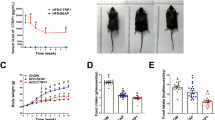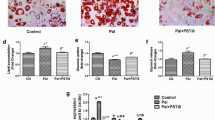Abstract
To investigate whether and on which pathway dietary calcium influence the obesity induced by high-fat diet, thirty male Kunming mice were fed in six groups for 4 weeks and mouse preadipocytes were divided into eight groups for different treatment. Body weight gain was measured each week. Calcium in serum and tissues, intracellular free Ca2+ concentration ([Ca2+]i), blood fat and intracellular lipid content were also measured. The expression of Lipid metabolism-related genes were measured by q RT-PCR. Compared with control group, body weight gain (P < 0.05) and fat pad weight (P < 0.01) in Low calcium group decreased. Triglycerides (TG) and total Cholesterol (TC) level decreased (P < 0.01), while HDL-Cholesterol (HDL) level increased (P < 0.01). And calcium supply increased calcium content in blood serum and tissues. In tissues, adipogenesis and vitamin D receptor (VDR) genes expression decreased but lipoclasis genes expression increased. These anti-obesity effects were more obvious when supplying with 2.8% calcium, but the effects were reduced while supplying Nifedipine at the same time. The results in preadipocytes indicated that calcium-treated can reduce intracellular lipid content, along with adipogenesis and lipoclasis genes expression decrease, promoted the expression levels of p38 MAPK pathway upstream gene MKK6 (P < 0.01) and downstream gene MAPKAPK2 (P < 0.01). Treated with SB203580 could increase adipogenesis genes expression, decrease lipoclasis genes expression and ([Ca2+]i) (P < 0.01). These results implied that dietary calcium had remarkable effect on anti-obesity effect and p38 MAPK pathway potentially participated in calcium-mediated lipid accumulation and lipolysis in mouse preadipocytes.




Similar content being viewed by others
References
Boon N, Goossens GH, Blaak EE et al (2007) The effects of hydralazine on lipolysis in subcutaneous adipose tissue in humans. Metabolism 56:1742–1748. doi:10.1016/j.metabol.2007.08.003
Parra P, Bruni G, Palou A et al (2008) Dietary calcium attenuation of body fat gain during high-fat feeding in mice. J Nutr Biochem 19:109–117. doi:10.1016/j.jnutbio.2007.01.009
Palacios C, Benedetti P, Fonseca S (2007) Impact of calcium intake on body mass index in Venezuelan adolescents. J PR Health Sci 26:199–204
Carruth BR, Skinner JD (2001) The role of dietary calcium and other nutrients in moderating body fat in preschool children. Int J Obes Relat Metab Disord 25:559–566
Heaney RP (2003) Normalizing calcium intake: projected population effects for body weight. J Nutr 133:268S–270S
Zhang Q, Tordoff MG (2004) No effect of dietary calcium on body weight of lean and obese mice and rats. Am J Physiol Regul Integr Comp Physiol 286:R669–R677. doi:10.1152/ajpregu.00655.20030363-6119/04
Paradis S, Cabanac M (2005) Calcium deficiency cannot induce obesity in rats. Physiol Behav 85:259–264. doi:10.1016/j.physbeh.2005.03.026
Boon N, Hul GB, Viguerie N et al (2005) Effects of 3 diets with various calcium contents on 24-h energy expenditure, fat oxidation, and adipose tissue message RNA expression of lipid metabolism-related proteins. Am J Clin Nutr 82:1244–1252
Boon N, Hul GB, Sicard A et al (2006) The effects of increasing serum calcitriol on energy and fat metabolism and gene expression. Obesity (Silver Spring) 14:1739–1746. doi:10.1038/oby.2006.200
Zhao YP, Zhang CM, Zhu C et al (2010) NYGGF4 homologous gene expression in 3T3–L1 adipocytes: regulation by FFA and adipokines. Mol Bio Rep 37(7):3291–3296. doi:10.1007/s11033-009-9914-7
Drolet R, Richard C, Sniderman AD, Mailloux J, Fortier M et al (2008) Hypertrophy and hyperplasia of abdominal adipose tissues in women. Int J Obes 32:283–291
Junghyo J, Oksana G, Stephanie P et al (2009) Hypertrophy and/or hyperplasia: dynamics of adipose tissue growth. PLoS Comput Biol 5:1–11
Jensen B, Farach-Carson MC, Kenaley E et al (2004) High extracellular calcium attenuates adipogenesis in 3T3–L1 preadipocytes. Exp Cell Res 301:280–292. doi:10.1016/j.yexcr.2004.08.030
Aouadi M, Jager J, Laurent K et al (2007) p38MAP Kinase activity is required for human primary adipocyte differentiation. FEBS Lett 581:5591–5596. doi:10.1016/j.febslet.2007.10.064
Aouadi M, Laurent K, Prot M, Le Marchand-Brustel Y, Binetruy B, Bost F (2006) Inhibition of p38MAPK increases adipogenesis from embryonic to adult stages. Diabetes 55:281–289. doi:10.2337/diabetes.55.02.06.db05-0963
Han HJ, Lee YJ (2005) Insulin stimulates Ca2+ uptake via PKC, cAMP, and p38 MAPK in mouse embryonic stem cells. Life Sci 76:2903–2919. doi:10.1016/j.lfs.2004.10.060
Livak KJ, Schmittgen TD (2001) Analysis of relative gene expression data using real-time quantitative PCR and the 2−ΔΔCT method. Methods 25:402–408. doi:10.1006/meth.2001.1262
Lorenzen JK, Nielsen Sanne, Holst JJ et al (2007) Effect of dairy calcium or supplementary calcium intake on postprandial fat metabolism, appetite, and subsequent energy intake. Am J Clin Nutr 85:678–687
Zhai GY, Xue HZ, Wang P et al (2008) Synthesis and lowering cholesterol effect of rutin calcium complex. Chem Res 19:25–27
Zemel MB, Thompson W, Milstead A, Morris K, Campbell P (2004) Calcium and dairy acceleration of weight and fat loss during energy restriction in obese adults. Obes Res 12:582–590. doi:10.1038/oby.2004.67
Wagner G, Kindrick S, Hertzler SM, DiSilvesto RA (2007) Effects of various forms of calcium on body weight and bone turnover markers in women participating in a weight loss program. J Am Coll Nutr 26:456–461
Wang HY, Sun CH, Zhou XR et al (2004) Mechanism of dietary calcium on reducing body weight of obese rats induced by diets. Chin J Public Health 20:1046–1047
Han JX, Liu L, Dong CC et al (2003) Effects of Nimodipine and calcichew-D3 on the calcium concentration of the blood and viscera of SAMP6 mice. Med J Chin People’s Liberation Army 14:265–268
Tontonoz P, Hu E, Spiegelman BM (1994) Stimulation of adipogenesis in fibroblasts by PPARγ2, a lipid-activated transcription factor. Cell 79:1147–1156. doi:10.1016/0092-8674(94)90006-X
Jeong Sunhyo, Yoon Michung (2011) 17β-Estradiol inhibition of PPARγ-induced adipogenesis and adipocyte-specific gene expression. Acta Pharmacol Sin 32:230–238. doi:10.1038/aps.2010.198
RH Lu, Ji H, Chang ZG et al (2010) Mitochondrial development and the influence of its dysfunction during rat adipocyte differentiation. Mol Bio Rep 37(5):2173–2182. doi:10.1007/s11033-009-9695-z
Wang S, Soni KG, Semache M et al (2008) Lipolysis and the integrated physiology of lipid energy metabolism. Mol Gene Metab 95:117–126
Sun C, Wei ZW, Li Y (2011) DHA regulates lipogenesis and lipolysis genes in mice adipose and liver. Mol Bio Rep 38(2):731–737. doi:10.1007/s11033-010-0160-9
Engelman JA, Lisanti MP, Scherer PE (1998) Specific inhibitors of p38 mitogen-activated protein kinase block 3T3-L 1 adipogenesis. Biol Chem 273:32111–32120. doi:10.1074/jbc.273.48.3211
Engelman JA, Berg AH, Lewis RY et al (1999) Constitutively active mitogen-activated protein kinase kinase 6 (MKK6) or salicylate induces spontaneous 3T3–L1 adipogenesis. J Biol Chem 274:35630–35638. doi:10.1074/jbc.274.50.35630
Zarubin T, Han J (2005) Activation and signaling of the p38 MAP kinase pathway. Cell Res 15:11–18. doi:10.1038/sj.cr.7290257
Kyriakis JM, Avruch J (2001) Mammalian mitogen-activated protein kinase signal transduction pathways activated by stress and inflammation. Physiol Rev 81:807–869
Sudo Tatsuhiko, Kawai Kayoko, Matsuzaki Hiroshi et al (2005) p38 mitogen- activated protein kinase plays a key role in regulating MAPKAPK2 expression. Biochem Bioph Res Co 337:415–421. doi:10.1016/j.bbrc.2005.09.063
Acknowledgments
This work was supported by a grant from The National Nature Science Foundation of China (30871785) and the Program for New Century Excellent Talents in Universities, Chinese Ministry of Education (NCET-06-0865) and the fund of International Science and Technology Cooperation.
Author information
Authors and Affiliations
Corresponding author
Electronic supplementary material
Below is the link to the electronic supplementary material.
Rights and permissions
About this article
Cite this article
Sun, C., Wang, L., Yan, J. et al. Calcium ameliorates obesity induced by high-fat diet and its potential correlation with p38 MAPK pathway. Mol Biol Rep 39, 1755–1763 (2012). https://doi.org/10.1007/s11033-011-0916-x
Received:
Accepted:
Published:
Issue Date:
DOI: https://doi.org/10.1007/s11033-011-0916-x




